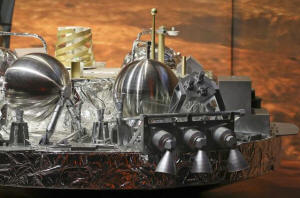|
Europe's Mars probe destroyed after
plunging to surface
 Send a link to a friend
Send a link to a friend
 [October 22, 2016]
By Maria Sheahan [October 22, 2016]
By Maria Sheahan
FRANKFURT (Reuters) - Images taken by a
NASA Mars orbiter indicate that a missing European space probe was
destroyed on impact after plummeting to the surface of the Red Planet
from a height of 2-4 km (1.2 to 2.5 miles), the European Space Agency
said on Friday.
The disc-shaped, 577-kg (1,272 lb) Schiaparelli probe, part of the
Russian-European ExoMars program to search for evidence of life on Mars,
descended on Wednesday to test technologies for a rover that scientists
hope to send to the surface of the planet in 2020.
But contact with the vehicle was lost around 50 seconds before the
expected landing time, leaving its fate uncertain until the NASA images
were received.
"Schiaparelli reached the ground with a velocity that was much higher
than it should have been, several hundred kilometers per hour, and was
then unfortunately destroyed by the impact," ExoMars Flight Director
Michel Denis told Reuters TV.
It was only the second European attempt to land a craft on Mars, after a
failed mission by the British landing craft Beagle 2 in 2003.
The U.S. space agency's Mars Reconnaissance Orbiter, which has been
circling the planet for about 10 years, took low-resolution pictures
that show a bright spot that ESA believes is the 12-metre parachute that
Schiaparelli used to slow down. (http://bit.ly/2efEs3u)

They also show a fuzzy dark patch, around 15 by 40 meters in size, about
1 km north of the parachute, which scientists interpret as having been
created by the impact of the lander following a longer-than-planned free
fall.
ESA said it was possible that Schiaparelli's landing was accompanied by
an explosion, as its thrusters' fuel tanks were probably still full.
The primary part of the ExoMars mission has, however, been a success so
far, as the Schiaparelli lander's mothership has been brought into orbit
around Mars, from where it will try to sniff out methane and other gases
that might indicate the presence of life. It will also act as a data
relay station for the rover, which is due to follow in 2020.
HOSTILE ENVIRONMENT
Landing on Mars, Earth's neighbor and at its closest some 35 million
miles (56 million km) away, is a notoriously difficult task that has
thwarted most Russian efforts and given NASA trouble as well.
[to top of second column] |

A full-size model of the European ExoMars entry, descent and landing
module, Schiaparell is seen during a press conference at the
European Space Agency (ESA) Headquarters in Darmstadt, Germany
October 20, 2016. REUTERS/Kai Pfaffenbach

That has not diminished its allure, with U.S. President Barack Obama
recently highlighting his pledge to send people to the surface by
the 2030s.
Entrepreneur Elon Musk's SpaceX is developing a massive rocket and
capsule to transport large numbers of people and cargo to Mars with
the ultimate goal of colonizing the planet.
ESA scientists have been poring over data that the Schiaparelli
lander transmitted before its signal was lost, to look for clues as
to what happened. They found that a heat shield and parachute
intended to slow the craft down from a speed of 21,000 km per hour
deployed as expected.
"But somehow the parachute was released a bit too early, and after
that the engine functioned, but only for a few seconds, which was
too little," ESA's Denis said.
The space agency said that NASA's orbiter would take pictures with
its highest-resolution camera next week, which may provide further
clues.
ESA Director General Jan Woerner said earlier that the ExoMars
mission had been "96 percent" successful so far, despite problems
with the lander, as the orbiter was functioning well and the
experience with Schiaparelli would still provide valuable lessons
for future attempts to land on Mars.
(Reporting by Maria Sheahan; Editing by Georgina Prodhan and Mark
Trevelyan)
[© 2016 Thomson Reuters. All rights
reserved.]
Copyright 2016 Reuters. All rights reserved. This material may not be published,
broadcast, rewritten or redistributed.

 |